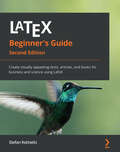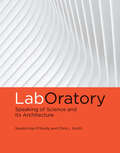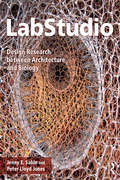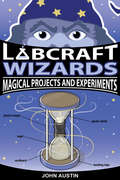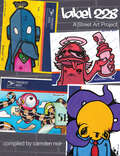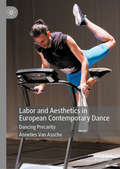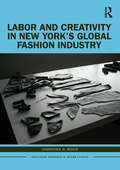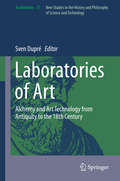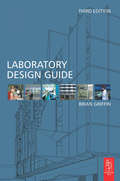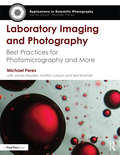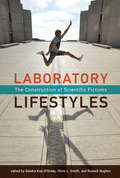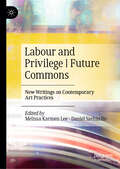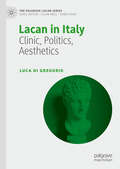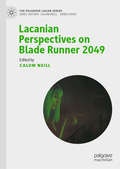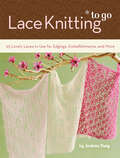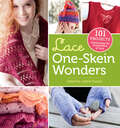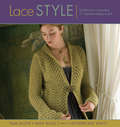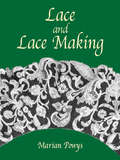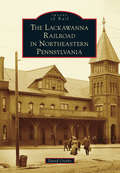- Table View
- List View
LaTeX Beginner's Guide: Create visually appealing texts, articles, and books for business and science using LaTeX, 2nd Edition
by Stefan KottwitzHarness the power of LaTeX and its wide range of features to create professional-looking text, articles, and books with both online and offline capabilities of LaTeXKey FeaturesGet a hands-on introduction to LaTeX using fully explained examples to advance from beginner to LaTeX professional quicklyWrite impressive mathematical, scientific, and business papers or theses using LaTeXExplore LaTeX onlineBook DescriptionLaTeX is high-quality open source typesetting software that produces professional prints and PDF files. It's a powerful and complex tool with a multitude of features, so getting started can be intimidating. However, once you become comfortable with LaTeX, its capabilities far outweigh any initial challenges, and this book will help you with just that! The LaTeX Beginner's Guide will make getting started with LaTeX easy. If you are writing mathematical, scientific, or business papers, or have a thesis to write, this is the perfect book for you. With the help of fully explained examples, this book offers a practical introduction to LaTeX with plenty of step-by-step examples that will help you achieve professional-level results in no time. You'll learn to typeset documents containing tables, figures, formulas, and common book elements such as bibliographies, glossaries, and indexes, and go on to manage complex documents and use modern PDF features. You'll also get to grips with using macros and styles to maintain a consistent document structure while saving typing work. By the end of this LaTeX book, you'll have learned how to fine-tune text and page layout, create professional-looking tables, include figures, present complex mathematical formulas, manage complex documents, and benefit from modern PDF features.What you will learnMake the most of LaTeX's powerful features to produce professionally designed textsDownload, install, and set up LaTeX and use additional styles, templates, and toolsTypeset math formulas and scientific expressions to the highest standardsUnderstand how to include graphics and work with figures and tablesDiscover professional fonts and modern PDF featuresWork with book elements such as bibliographies, glossaries, and indexesTypeset documents containing tables, figures, and formulasWho this book is forIf you are about to write mathematical or scientific papers, seminar handouts, or even plan to write a thesis, this book offers you a fast-paced and practical introduction to LaTeX. School and university students will find this easy-to-follow LaTeX guide helpful, as will mathematicians, physicists, engineers, and humanists. Anybody with high expectations from their software will discover how easy it is to leverage LaTeX's high performance for creating documents.
LabOratory: Speaking of Science and Its Architecture (The\mit Press Ser.)
by Chris L. Smith Sandra Kaji-O'GradyAn illustrated examination of laboratory architecture and the work that it does to engage the public, recruit scientists, and attract funding.The laboratory building is as significant to the twenty-first century as the cathedral was to the thirteenth and fourteenth centuries. The contemporary science laboratory is built at the grand scales of cathedrals and constitutes as significant an architectural statement. The laboratory is a serious investment in architectural expression in an attempt to persuade us of the value of the science that goes on inside. In this lavishly illustrated book, Sandra Kaji-O'Grady and Chris L. Smith explore the architecture of modern life science laboratories, and the work that it does to engage the public, recruit scientists, and attract funding.Looking at the varied designs of eleven important laboratories in North America, Europe, and Australia, all built between 2005 and 2019, Kaji-O'Grady and Smith examine the relationship between the design of contemporary laboratory buildings and the ideas and ideologies of science. Observing that every laboratory architect and client declares the same three aspirations—to eliminate boundaries, to communicate the benefits of its research programs, and to foster collaboration—Kaji-O'Grady and Smith organize their account according to the themes of boundaries, expression, and socialization. For instance, they point to the South Australian Health and Medical Institute's translucent envelope as the material equivalent of institutional accountability; the insistent animal imagery of the NavarraBioMed laboratory in Spain; and the Hillside Research Campus's mimicry of the picturesque fishing village that once occupied its site. Through these and their other examples, Kaji-O'Grady and Smith show how the architecture of the laboratory shapes the science that takes place within it.
LabStudio: Design Research between Architecture and Biology
by Jenny E. Sabin Peter Lloyd JonesLabStudio: Design Research between Architecture and Biology introduces the concept of the research design laboratory in which funded research and trans-disciplinary participants achieve radical advances in science, design, and applied architectural practice. The book demonstrates to natural scientists and architects alike new approaches to more traditional design studio and hypothesis-led research that are complementary, iterative, experimental, and reciprocal. These originate from 3-D spatial biology and generative design in architecture, creating philosophies and practices that are high-risk, non-linear, and design-driven for often surprising results.Authors Jenny E. Sabin, an architectural designer, and Peter Lloyd Jones, a spatial biologist, present case studies, prototypes, and exercises from their practice, LabStudio, illustrating in hundreds of color images a new model for seemingly unrelated, open-ended, data-, systems- and technology-driven methods that you can adopt for incredible results.
Labcraft Wizards: Magical Projects and Experiments
by John AustinBeing a wizard takes training, practice, and a few tips from an expert. Author and professional toy designer John Austin, creator of the popular MiniWeapons of Mass Destruction series, provides dozens of projects for up-and-coming sorcerers. Each of the 35 projects in Labcraft Wizards is explained through illustrated step-by-step instructions and uses simple, everyday materials. Build an Enchanted Hourglass out of empty soda bottles, plastic hangers, and sand. Transform a chicken egg into a colorful, bouncy Dragon Egg using vinegar and food coloring or mix up a batch of Ogre Snot with corn syrup and gelatin. Through its creative activities, Labcraft Wizards helps eager minds explore basic concepts in chemistry and physics through experimentation, encourages scientific observation, and fuels imaginations.
Label 228: A Street Art Project
by Camden NoirLabel 228 is a gathering of street art executed on priority mail labels (Label 228, in official parlance) and displayed in public spaces. It’s a remarkably prevalent method of exposure featured by graffiti artists worldwide. These labels are free, portable, and quick and easy to exhibit, offering artists the chance to spend more time creating their work than if they were to paint and write directly on walls, vehicles, and public objects.camden noir launched his Label 228 project by putting out a call to artists, asking them to send him their artwork or anything, for that matter, on priority mail labels. Within six months, he received over 500 labels from artists all over the world. At this point, he has over 1,500 labels from over 600 artists. This is a collection of the best of those labels, in a beautiful, full-color book.The artists featured in Label 228 include Mecro, Downtimer, Mat Curran, Daniel Fleres, Zoso, Aaron Kraten, Lightsleepers, David Flores, Matt Linares, Kegr, Josh Taylor, Robots Will Kill!, Nano, Dolla, and many more.
Labor Unrest in Scranton
by Marnie Azzarelli Margo L. AzzarelliOn an August morning in 1877, a dispute over wages exploded between miners and coal company owners. A furious mob rushed down Lackawanna Avenue only to be met by a deadly hail of bullets. With its vast coal fields, mills and rail lines, Scranton became a hotbed for labor activity. Many were discontented by working endless and dangerous hours for minimal pay. The disputes mostly ended in losses for labor, but after a strike that lasted more than one hundred days, John Mitchell helped win higher wages, a shorter workday and better working conditions for coal miners. The legendary 1902 Anthracite Coal Strike Commission hearings began in Scranton, where famed lawyer Clarence Darrow championed workers' rights. Local authors Margo and Marnie Azzarelli present this dramatic history and its lasting legacy.
Labor and Aesthetics in European Contemporary Dance: Dancing Precarity
by Annelies Van AsscheThis transdisciplinary study scientifically reports the way the established contemporary dance sector in Europe operates from a micro-perspective. It provides a dance scholarly and sociological interpretation of its mechanisms by coupling qualitative data (interview material, observations, logbooks, and dance performances) to theoretical insights. The book uncovers the sometimes contradicting mechanisms related to the precarious project-oriented labor and art market that determine the working and living conditions of contemporary dance artists in Europe’s dance capitals Brussels and Berlin. In addition, it examines how these working and living conditions affect the work process and outcome. From a sociological perspective, the book engages with the relevant contemporary social issue of precarity and this within the much-at-risk professional group of contemporary dance artists. In this regard, the research brings novelty within the subject area, particularly by employing a unique methodological approach. Although the research is initially set up in a specific geographical context and within a specific research population, the book offers insights into issues that affect our neoliberal society at large. The research findings show potential to make a relevant contribution with regards to precarity within dance studies and performance studies, but also labor studies and cultural sociology.
Labor and Creativity in New York’s Global Fashion Industry (Routledge Research in Design Studies)
by Christina H. MoonThis book tells the story of fashion workers engaged in the labor of design and the material making of New York fashion. Christina H. Moon offers an illuminating ethnography into the various sites and practices that make up fashion labor in sample rooms, design studios, runways, factories, and design schools of the New York fashion world. By exploring the work practices, social worlds, and aspirations of fashion workers, this book offers a unique look into the meaning of labor and creativity in 21st century global fashion. This book will be of interest to scholars in design studies, fashion history, and fashion labor.
Labor and Laborers of the Loom: Mechanization and Handloom Weavers, 1780-1840 (Studies in American Popular History and Culture)
by Gail Fowler MohantyLabor and Laborers of the Loom: Mechanization and Handloom Weavers 1780-1840 develops several themes important to understanding the social, cultural and economic implications of industrialization. The examination of these issues within a population of extra-factory workers distinguishes this study. The volume centers on the rapid growth of handloom weaving in response to the introduction of water powered spinning. This change is viewed from the perspectives of mechanics, technological limitations, characteristics of weaving, skills, income and cost. In the works of Duncan Bythell and Norman Murray the displacement of British and Scottish hand weavers loomed large and the silence of American handloom weavers in similar circumstances was deafening. This study reflects the differences between the three culture by centering not on displacement but on survival. Persistence is closely tied to the gradual nature of technological change. The contrasts between independent commercial artisans and outwork weavers are striking. Displacement occurs but only among artisans devoting their time to independent workshop weaving. Alternatively outwork weavers adapted to changing markets and survived. The design and development of spinning and weaving device is stressed, as are the roles of economic conditions, management organization, size of firms, political implications and social factors contribute to the impact of technological change on outwork and craft weavers.
Laboratories of Art
by Sven DupréThis book explores the interconnections and differentiations between artisanal workshops and alchemical laboratories and between the arts and alchemy from Antiquity to the eighteenth century. In particular, it scrutinizes epistemic exchanges between producers of the arts and alchemists. In the fifteenth and sixteenth centuries the term laboratorium uniquely referred to workplaces in which 'chemical' operations were performed: smelting, combustion, distillation, dissolution and precipitation. Artisanal workshops equipped with furnaces and fire in which 'chemical' operations were performed were also known as laboratories. Transmutational alchemy (the transmutation of all base metals into more noble ones, especially gold) was only one aspect of alchemy in the early modern period. The practice of alchemy was also about the chemical production of things--medicines, porcelain, dyes and other products as well as precious metals and about the knowledge of how to produce them. This book uses examples such as the Uffizi to discuss how Renaissance courts established spaces where artisanal workshops and laboratories were brought together, thus facilitating the circulation of materials, people and knowledge between the worlds of craft (today's decorative arts) and alchemy. Artisans became involved in alchemical pursuits beyond a shared material culture and some crafts relied on chemical expertise offered by scholars trained as alchemists. Above all, texts and books, products and symbols of scholarly culture played an increasingly important role in artisanal workshops. In these workplaces a sort of hybrid figure was at work. With one foot in artisanal and the other in scholarly culture this hybrid practitioner is impossible to categorize in the mutually exclusive categories of scholar and craftsman. By the seventeenth century the expertise of some glassmakers, silver and goldsmiths and producers of porcelain was just as based in the worlds of alchemical and bookish learning as it was grounded in hands-on work in the laboratory. This book suggests that this shift in workshop culture facilitated the epistemic exchanges between alchemists and producers of the decorative arts.
Laboratory Design Guide: For Clients, Architects And Their Design Team: The Laboratory Design Process From Start To Finish
by Brian GriffinLaboratory Design Guide 3rd edition is a complete guide to the complex process of laboratory design and construction. With practical advice and detailedexamples, it is an indispensable reference for anyone involved in building or renovating laboratories.In this working manual Brian Griffin explains how to meet the unique combination of requirements that laboratory design entails. Considerations range from safety and site considerations to instrumentation and special furniture, andaccommodate the latest laboratory practices and the constant evolution of science. Case studies from around the world illustrate universal principles ofgood design while showing a variety of approaches.Revised throughout for this new edition, the book contains a brand new chapter on the role of the computer, covering topics such as the virtual experiment, hot desking, virtual buildings and computer-generated space relationship diagrams.There are also 10 new international case studies, including the Kadoorie Biological Sciences Building at the University of Hong Kong.
Laboratory Imaging & Photography: Best Practices for Photomicrography & More (Applications in Scientific Photography)
by Michael PeresLaboratory Imaging and Photography: Best Practices for Photomicrography and More is the definitive guide to the production of scientific images. Inside, the reader will find an overview of the theory and practice of laboratory photography, along with useful approaches to choosing equipment, handling samples, and working with microscopic subjects. Drawing from over 150 years of combined experience in the field, the authors outline methods of properly capturing, processing and archiving the images that are essential to scientific research. Also included are chapters on applied close-up photography, artificial light photography and the optics used in today’s laboratory environment, with detailed entries on light, confocal and scanning electron microscopy. A lab manual for the digital era, this peerless reference book explains how to record visual data accurately in an industry where a photograph can serve to establish a scientific fact. Key features include: Over 200 full-color photographs and illustrations A condensed history of scientific photography Tips on using the Adobe Creative Suite for scientific applications A cheat sheet of best practices Methods used in computational photography
Laboratory Lifestyles: The Construction of Scientific Fictions (Leonardo)
by Chris Smith Russell Hughes Sandra Kaji-O'GradyA generously illustrated examination of the boom in luxurious, resort-style scientific laboratories and how this affects scientists' work. The past decade has seen an extraordinary laboratory-building boom. This new crop of laboratories features spectacular architecture and resort-like amenities. The buildings sprawl luxuriously on verdant campuses or sit sleekly in expensive urban neighborhoods. Designed to attract venture capital, generous philanthropy, and star scientists, these laboratories are meant to create the ideal conditions for scientific discovery. Yet there is little empirical evidence that shows if they do. Laboratory Lifestyles examines this new species of scientific laboratory from architectural, economic, social, and scientific perspectives. Generously illustrated with photographs of laboratories and scientists at work in them, the book investigates how “lifestyle science” affects actual science. Are scientists working when they stretch in a yoga class, play volleyball in the company tournament, chat in an on-site café, or show off their facilities to visiting pharmaceutical executives?The book describes, among other things, the role of beanbag chairs in the construction of science at Xerox PARC; the Southern California vibe of the RAND Corporation (Malibu), General Atomic (La Jolla), and Hughes Research Laboratories (Malibu); and Biosphere 2's “bionauts” as both scientists and scientific subjects; and interstellar laboratories. Laboratory Lifestyles (the title is an allusion to Bruno Latour and Steve Woolgar's influential Laboratory Life) documents a shift in what constitutes scientific practice; these laboratories and their lifestyles are as experimental as the science they cultivate. Contributors Kathleen Brandt, Russell Hughes, Tim Ivison, Sandra Kaji-O'Grady, Stuart W. Leslie, Brian Lonsway, Sean O'Halloran, Simon Sadler, Chris L. Smith, Nicole Sully, Ksenia Tatarchenko, William Taylor, Julia Tcharfas, Albena Yaneva, Stelios Zavos
Labour and Privilege | Future Commons: New Writings on Contemporary Art Practices
by Melissa Karmen Lee Daniel Szehin HoThis book project was part of an annual series of Summer seminars held at Hong Kong's Tai Kwun Centre for Heritage and Arts, which brought the intellectual community together to debate the social issues of the day. The artists, writers, and scholars included in these texts represent unconventional thinkers completing rigorous scholarship that we think is important to be published today, as Hong Kong seeks for social and political alternatives. This book will be of interest to public intellectuals, political/cultural theorists and thinkers, as well as the international art community.
Lacan + Architecture (The Palgrave Lacan Series)
by John Shannon Hendrix Francesco ProtoThis book seeks to revise and revive architectural theory through psychoanalysis as well as to apply psychoanalytic theory to architecture. Its authors argue for Lacan’s central importance for a comprehensive theory of building and suggest how architectural theory might offer new resources for psychoanalytic theorists. They address both the perceived crisis in the contemporary state of architecture and architectural theory and crises in society at large, including political and economic fracture and instability and threats to mental health and well-being. It offers fresh insights to architects, architectural educators and practitioners, scholars of psychoanalysis, and anyone interested in the human condition in relation to the built environment.
Lacan in Italy: Clinic, Politics, Aesthetics (The Palgrave Lacan Series)
by Luca Di GregorioThis book provides the first analysis of the reception and development of Lacanian psychoanalysis in Italy, offering a comprehensive account of the relevance and contributions of Italian Lacanians. It examines Italian Lacanianism through its distinctive engagement with clinical practice, sociopolitical analysis, and aesthetics, highlighting the work of influential figures such as Sergio Benvenuto and Massimo Recalcati. Lacan in Italy proposes a nuanced understanding of how Italian Lacanians reinterpret Lacan&’s legacy, advancing an affirmative approach to the notion of the real – often conceptualised in negative terms as traumatic, impossible, unrepresentable, and unsymbolisable – by emphasising its generative, life-affirming potential. The book also fosters dialogue with Lacanian receptions across different countries and languages.
Lacan, Psychoanalysis, and Comedy
by Patricia Gherovici Manya SteinkolerThis collection of essays explores laughter, humor, and the comic from a psychoanalytic perspective. Edited by two leading practicing psychoanalysts and with original contributions from Lacanian practitioners and scholars, this cutting-edge volume proposes a paradigm swerve, a Freudian slip on a banana peel. Psychoanalysis has long been associated with tragedy and there is a strong warrant to take up comedy as a more productive model for psychoanalytic practice and critique. Jokes and the comic have not received nearly as much consideration as they deserve given the fundamental role they play in our psychic lives and the way they unite the fields of aesthetics, literature, and psychoanalysis. Lacan, Psychoanalysis and Comedy addresses this lack and opens up the discussion.
Lacanian Perspectives on Blade Runner 2049 (The Palgrave Lacan Series)
by Calum NeillThis book provides a collection of Lacanian responses to Denis Villeneuve’s Blade Runner 2049 from leading theorists in the field. Like Ridley Scott’s original Blade Runner film, its sequel is now poised to provoke philosophical and psychoanalytic arguments, and to provide illustrations and inspiration for questions of being and the self, for belief and knowledge, the human and the post-human, amongst others. This volume forms the vanguard of responses from a Lacanian perspective, satisfying the hunger to extend the theoretical considerations of the first film in the various new directions the second film invites. Here, the contributors revisit the implications of the human-replicant relationship but move beyond this to consider issues of ideology, politics, and spectatorship. This exciting collection will appeal to an educated film going public, in addition to students and scholars of Lacanian psychoanalysis, psychoanalytic theory, cultural studies, film theory, philosophy and applied psychoanalysis.
Lace Knitting To Go: 25 Lovely Laces to Use for Edgings, Embellishments, and More
by Andrea TungNew and experienced knitters can try their hand at lace knitting—the style taking the yarn shops and runways by storm.Lace knitting is not just for shawls or doilies! It can be sweet or sexy, depending on how much you choose to reveal. Lace trim adds flair to your jeans, and you can use shimmering crystal beads and satin ribbons within your pattern to add glamour and sparkle to a plain sweater or dress. This fantastic book includes twenty-five hip and modern patterns perfect for incorporating into any knitted project. Along with detailed instructions on a specific lace pattern, you’ll find an easy-to-read graph for guidance and a full-color photograph of the finished project. Not just a reference for stitch patterns, Lace Knitting to Go also serves as a source of inspiration—a jumping-off point for your own creativity and exploration in the world of lace.
Lace One-Skein Wonders®: 101 Projects Celebrating the Possibilities of Lace (One-Skein Wonders)
by Judith DurantStretch a single skein of yarn into a complete knitted lace project. Knitters of all levels will be thrilled by the dizzying array of lace wonders that can be created with such a small fiber sample. Try your hand at an heirloom-quality lace shawl, light and airy curtains, cozy baby blankets, a dainty child’s dress, and much more. With clear instructions for 101 projects contributed by designers and knitters from around the world, you’ll be inspired to pull out your needles and get knitting.
Lace Style: Traditional To Innovative, 21 Inspired Designs To Knit (Style Ser.)
by Pam Allen Ann BuddWith an emphasis on innovative designs that range from simple to complex, this collection of contemporary knitting projects includes garments and accessories for women. Featuring projects with a sense of style that will appeal to knitters of all ages, it includes designs for socks, hats, sweaters, dresses, and shrugs. A basic primer on knitting lace that is closely linked to the projects in the book includes information on how to knit lace, choosing yarn and needles, types of increases and decreases, reading charts, simple ways to achieve a lacy effect, ways to incorporate lace designs in knitting patterns, and information on blocking. Each pattern has detailed step-by-step instructions, lavish lifestyle photographs, and plenty of detail shots. Experienced knitters looking for inspiration and beginners trying lace knitting for the first time will find everything needed to knit lace with confidence.
Lace and Lace Making (Dover Knitting, Crochet, Tatting, Lace Ser.)
by Marian PowysOne of the most venerable crafts of the past, lacemaking still enjoys great popularity among needleworkers, for unlike anything else made by hand, lace is a "unique aesthetic creation." This comprehensive book by a skilled designer and internationally acknowledged authority on the subject covers all facets of lace and lacemaking. Written with charm and enthusiasm, the work covers the history of lace; explains how various types of lace were named; the uses of lace in design and decoration, on ecclesiastical garments and bridal gowns, and as personal adornment.Readers will also find detailed examination of lace collecting and the techniques of making, mending, cleaning, and caring for lace, while more than 100 large photographs offer splendid examples of Honiton, Flemish Pillow Lace, Irish Needlerun Tambour Lace, Brussels Rose Point, Point D'Angleterre, Hapsburg Lace, Point d'Alençon, Point de Venise, Reticello, Punto in Aria, and other important laces.An invaluable Key of Lace describes scores of lace types, with information on date of origin and designs. Also included are complete instructions and drawings for making pillow lace and needlepoint lace.
Lackawanna Railroad in Northeastern Pennsylvania, The
by David CrosbyThe Delaware, Lackawanna & Western Railroad, better known as the Lackawanna Railroad, was organized in 1851 and thrived on the anthracite coal traffic originating from the area surrounding Scranton, Pennsylvania. The company came to operate a network of track between Hoboken, New Jersey, and Buffalo, New York, before becoming part of the Erie Lackawanna Railway in 1960. During the first decade of the 1900s, the railroad underwent a substantial modernization and improvement project, which was documented extensively by company-hired photographers. A century later, these images provide a fascinating insight into the everyday workings of a railroad and its interaction with the communities along its route. Nearly all of the railroad territory covered by this book remains in operation today.
Lacombe Lucien: The Screenplay
by Patrick Modiano Sabine Destrèe Louis MallePatrick Modiano and Louis Malle's screenplay for the Oscar-nominated film tells a powerful story set in World War II France of a seventeen-year-old boy who allies himself with collaborators, only to fall in love with a Jewish girl <P> This early work by the Nobel Prize winner Patrick Modiano relates the story of Lucien Lacombe: a poor boy in Nazi-occupied France who, rebuffed in his efforts to enter the Resistance for a taste of war, becomes a member of a sordid, pathetic group of Fascist collaborators who join the Gestapo in preying upon their countrymen. Lucien encounters the Horns, a Jewish family from Paris hiding in his provincial town. Inevitably, he must choose between the coarse appeal of violence and his emerging feelings of tenderness for the family's daughter, France. Amid the excesses brought on by the impending collapse of the Nazi occupation, Lucien and France come to live out an improbable idyll. This classic is an essential read for students and film lovers alike.
Lacrimae rerum: Ensayos sobre cine y ciberespacio
by Slavoj ZizekConsiderado el «séptimo arte», el cine ha sido y sigue siendo uno de los medios de comunicación de masas más importantes. <P><P>Desde la primera función en el sótano del Grand Café des Capucines de París hace algo más de cien años, hasta las grandes superproducciones de Hollywood que dominan las pantallas del mundo, el cine ha sido técnica e industria, entretenimiento y vehículo de expresión de ideas y sentimientos. <P><P>Partiendo de estas consideraciones y estudiando la labor de reconocidos directores, el filósofo y psicoanalista Slavoj Zizek, profundo conocedor del universo cinematográfico y de la influencia de los medios de comunicación en la sociedad contemporánea, reflexiona sobre los temas principales de estos maestros y sus motivaciones a la hora de situarse detrás de la cámara. <P><P>De la imposibilidad de hacer remakes de las películas de Alfred Hitchcock al pesimismo en la obra de Krzysztof Kieslowski; de la imagen de la mujer, la irracionalidad y la angustia en los trabajos de Andrei Tarkovski y David Lynch a la posibilidad imaginaria o real de desplazarse a través del tiempo y el espacio como los personajes de Matrix, Zizek desarrolla su imaginación crítica y su agudo sentido literario para atrapar al lector con imágenes, ideas y revelaciones que sorprenderán no solo a los buenos aficionados al cine, sino también a todos aquellos que deseen acercarse a los clásicos de la pantalla de la mano de este original y provocador filósofo.
